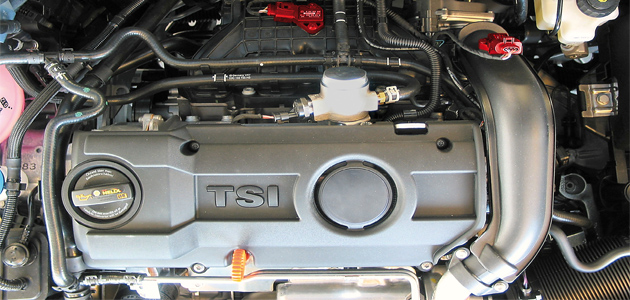
Potential complaints
• Fluctuating idle speed
• Loss of power
• Jerking on acceleration
• Malfunction Indicator Lamp illuminated
• Diagnostic Trouble Code P0105 – P0109
Error messages relating to the intake manifold pressure often appear in petrol engines that have intake manifold pressure measurement via a MAP (Manifold Air Pressure) sensor. Deviation from the expected values does not, however, lead to the DTC being stored in all operating states.

Intake manifold pressure sensor (red) in VW Golf IV
Determining the source
A scan tool can be used to compare the actual values with the known-good values. If the intake manifold pressure measured by the system deviates from the expected value, the actual value must be checked using a separate vacuum manometer.
- If the measured intake manifold pressure is within the known-good values, the MAP sensor and the electrical lines must be checked.
- If the measured intake manifold pressure is outside of the known-good values, the reason for the loss of pressure in the engine must be established.
Possible fault sources in the periphery of the engine
- Leaking intake manifolds downstream of the throttle valve (e.g.due to defective intake manifold gaskets, hoses, etc.)
- Defective engine exhaust valves/hoses
- Leaking brake boosters
- Leakages in the vacuum system (e.g.vacuum-operated actuators,brake boosters, lines, etc.)
- Defective EGR valves (permanently open)
- Defective idling actuators
- Idling status of the engine is not recognised by the control unit (defective throttle potentiometer, throttle switch)
- Defective or dirty throttle valves
- Incorrect or faulty air filter inserts
- Carbon deposits or other blockages in the intake manifold
If the problem is not found in the periphery of the engine, it must be assumed that there is a mechanical problem with the engine. This could include:
- Piston ring wear or piston damage (piston seizure, fusion and similar damage) – a further sign of this is high blow-by gas emission during idling with the oil filler cap open
- Leaking intake and exhaust valves
- Insufficient valve clearance
- Worn valve seat inserts (especially in engines with gas conversion)
- Incorrect function of the hydraulic valve clearance compensating elements (hydraulic tappet)
- Incorrectly set valve timing or skipped toothed belt
- Leaking cylinder head gaskets
- Incorrect or worn camshafts
We recommend that the following inspections are carried out:
- Valve clearance
- Valve timing check
- Compression test
- Cylinder compression test









